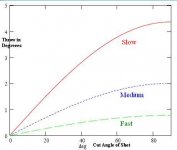One way to see it is to imagine the hard tip is extremely hard and that its contact time is extremely short. Hit a ball with with this tip at an offset of, say, 10 mm. The contact time is so short that the force both during compression and during decompression is acting at 10 mm. You will get a cueball with a spin/speed ratio characteristic of a 10mm offset.
Now hit the same shot with a normal tip with a 1 ms contact time. After compression of the tip the cueball has attained about half its forward speed and about half its spin. It's also moved forward some and rotated some so that the compressed tip has an offset of 10.5 mm instead of 10mm. Then the rest of the acceleration of the ball, during decompression, is occuring at offsets between, say 10.5 and 11.0 mm. I think this cueball, struck at 10 mm will have a spin/speed ratio characteristic of perhaps a 10.5 mm offset. Go now to a somewhat softer tip and the effective offset might increase to 10.6 mm.
If you ignore this effect, then I agree a soft tip and a hard tip give the same result: it's the impulse--the area under the force versus time curve--that matters.
mike page
fargo
